Assessing Streambed Stability Using D50-Based Stream Power Across Contiguous U.S.
Abstract
:1. Introduction
2. Materials and Methods
2.1. Stream Power
2.2. Sources of D50 and Hydrological Data
2.3. Scale of Analysis
2.4. Stream Power Screening Tool
2.5. Slope at D50 Data Points
2.6. Bankfull Discharge at D50 Data Points
3. Results and Discussion
3.1. Stream Power Screening Tool by Physiographic Provinces
3.2. Interpolation of Stream Power across Contiguous U.S.
3.3. Analysis of Stream Power Based on the Stream Order
3.4. Comparison with Long-Term Erosion/Deposition Temporal Data
4. Conclusions
- Stream power as a sole indicator for degradation/aggradation: This study relies on stream power to discretize the major geomorphological changes that could unfold in a stream channel. However, as noted by Bizzi and Lerner [13], stream power mainly accounts for the drivers of stream processes, slope, and discharge, with no characterization given to the resisting forces: sediments size distribution, bed lithology, and bedforms [12]. Yochum et al. [19] showed that variable stream power thresholds had been attributed to certain geomorphological changes in different studies, demonstrating the inadequacy of stream power to serve as a sole indicator of dominant channel processes. It is vital to understand and integrate both the driving and resisting forces while establishing threshold stream power values for actual channel condition prediction [16].
- Threshold limits on the screening tool: Threshold values of stream power for stream conditions were developed and recommended based on limited datasets. These were intended to be used in an environment that resembles the original study sites [25]. Application of these threshold values in a broad spatial extent with different streambed substrate types, channel geometry, and geological conditions can lead to an obscured result. Nevertheless, this study adopted a range of threshold values to discriminate between channel types, intending to encapsulate minimum stream power values required for erosion instigation in both coarse- and fine-bedded stream channels. The effect of streambed grain size was also accounted for here through the computation of critical stream power. This enhances the channel discrimination competency conducted here compared to previous studies that disregard the effect of particle size distribution while establishing stream power thresholds.
- Data limitation for large-scale application: The data used in this study was representative of the contiguous U.S. except for areas where spatial gaps were present. The data scarcity is majorly noticeable in the Great Plains, Basin and Range, and Colombia Plateaus provinces. Interpolation techniques used in the development of spatial maps highly depend on the density and distribution of data points. The accuracy of this map could have been improved if more data were available and added to the dataset. Nonetheless, the data presented in this study can serve as a foundation upon which a more comprehensive and representative analysis can be built.
Author Contributions
Funding
Institutional Review Board Statement
Informed Consent Statement
Data Availability Statement
Conflicts of Interest
References
- Bledsoe, B.; Baker, D.; Nelson, P.; Rosburg, T.; Sholtes, J.; Stroth, T. Design Hydrology for Stream Restoration and Channel Stability at Stream Crossings; The National Academies of Sciences, Engineering, and Medicine: Fort Collins, CO, USA, 2016; Available online: http://onlinepubs.trb.org/onlinepubs/nchrp/nchrp_rpt_853_FinalReport.pdf (accessed on 1 October 2022).
- Kaufmann, P.R.; Larsen, D.P.; Faustini, J.M. Bed stability and sedimentation associated with human disturbances in Pacific Northwest streams. J. Amer. Wat. Res. Assoc. 2009, 45, 434–459. [Google Scholar] [CrossRef]
- Piégay, H.; Darby, S.E.; Mosselman, E.; Surian, N. A review of techniques available for delimiting the erodible river corridor: A sustainable approach to managing bank erosion. Riv. Res. App. 2005, 21, 773–789. [Google Scholar] [CrossRef]
- Lagasse, P.F.; Schall, J.D.; Johnson, F.; Richardson, E.V.; Chang, F. Stream Stability at Highway Structures; U.S. Department of Transportation, FHWA-IP-90-014; 1995. Available online: https://rosap.ntl.bts.gov/view/dot/25666 (accessed on 1 October 2022).
- Simon, A.; Downs, P.W. An interdisciplinary approach to evaluation of potential instability in alluvial channels. Geomorphology 1995, 12, 215–232. [Google Scholar] [CrossRef]
- Soar, P.J.; Wallerstein, N.P.; Thorne, C.R. Quantifying river channel stability at the basin scale. Water 2017, 9, 133. [Google Scholar] [CrossRef] [Green Version]
- Brice, J.C. Stream Channel Stability Assessment; Tech Report FHWA/RD-82/021; U.S. Geological Survey: Menlo Park, CA, USA, 1982. Available online: https://rosap.ntl.bts.gov/view/dot/34974 (accessed on 1 October 2022).
- Johnson, P.A. Assessing Stream Channel Stability at Bridges in Physiographic Regions; VirginiaFHWA-HRT-05-072; U.S. Department of Transportation: McLean, VA, USA, 2006.
- Olsen, D.; Whitaker, A.C.; Potts, D.F. Assessing stream channel stability thresholds using flow competence estimates at bankfull stage. J. Am. Water Resour. Assoc. 1997, 33, 1197–1207. [Google Scholar] [CrossRef]
- Rosgen, D.L. A Stream Channel Stability Assessment Methodology. In Proceedings of the Seventh Federal Interagency Sedimentation Conference, Reno, Nevada, 25–29 March 2001. [Google Scholar]
- Lea, D.M.; Legleiter, C.J. Mapping spatial patterns of stream power and channel change along a gravel-bed river in northern Yellowstone. Geomorphology 2016, 252, 66–79. [Google Scholar] [CrossRef]
- Petit, F.; Gob, F.; Houbrechts, G.; Assani, A.A. Critical specific stream power in gravel-bed rivers. Geomorphology 2005, 69, 92–101. [Google Scholar] [CrossRef]
- Bizzi, S.; Lerner, D.N. The use of stream power as an indicator of channel sensitivity to erosion and deposition processes. Riv. Res. App. 2015, 31, 16–27. [Google Scholar] [CrossRef]
- Parker, C.; Clifford, N.J.; Thorne, C.R. Understanding the influence of slope on the threshold of coarse grain motion: Revisiting critical stream power. Geomorphology 2011, 126, 51–65. [Google Scholar] [CrossRef]
- Ferencevic, M.V.; Ashmore, P. Creating and evaluating dem-based stream power maps as a stream assessment tool. Riv. Res. App. 2012, 28. [Google Scholar] [CrossRef]
- MacBroom, J.G.; Schiff, R.; Louisos, J. River and Stream Power Assessment Report Including Culvert and Bridge Vulnerability Analysis: Deerfield River Basin; Water Resources and Extension at ScholarWorks@UMass: Amherst, MA, USA, 2017; Available online: https://scholarworks.umass.edu/water_reports/4 (accessed on 1 October 2022).
- Knighton, A.D. Downstream variation in stream power. Geomorphology 1999, 29, 293–306. [Google Scholar] [CrossRef]
- Habersack, H.M.; Laronne, J.B. Evaluation and improvement of bed load discharge formulas based on Helley–Smith sampling in an Alpine Gravel Bed River. J. Hydrau. Eng. 2002, 128, 484–499. [Google Scholar] [CrossRef]
- Yochum, S.E.; Sholtes, J.S.; Scott, J.A.; Bledsoe, B.P. Stream power framework for predicting geomorphic change: The 2013 Colorado Front Range Flood. Geomorphology 2017, 292, 178–192. [Google Scholar] [CrossRef]
- Cao, Z.; Hu, P.; Pender, G. Reconciled bedload sediment transport rates in ephemeral and perennial rivers. Earth Surf. Proc. Landf. 2010, 35, 1655–1665. [Google Scholar] [CrossRef]
- Nanson, G.C.; Croke, J.C. A genetic classification of floodplains. Geomorphology 1992, 4, 459–486. [Google Scholar] [CrossRef] [Green Version]
- Bledsoe, B.; Watson, C.; Biedenharn, D. Quantification of incised channel evolution and equilibrium. J. Am. Water Resour. Assoc. 2002, 38, 861–870. [Google Scholar] [CrossRef]
- Brookes, A. The distribution and management of channelized streams in Denmark. Regul. Rivers Res. Manag. 1987, 1, 3–16. [Google Scholar] [CrossRef]
- Miller, A.J. Flood hydrology and geomorphic effectiveness in the central Appalachians. Earth Sur. Proc. Landf. 1990, 15, 119–134. [Google Scholar] [CrossRef]
- Wishart, D.; Brookes, A. Application of a Stream Power Screening Tool. In Accounting for Sediment in Rivers—A Tool Box of Sediment Transport and Transfer Analysis Methods and Models to Support Hydromophologically-Sustainable Flood Risk Management in the UK; Research Report UR9; Wallerstein, N.P., Ed.; Flood Risk Management Research Consortium: Watlington, UK, 2006; pp. 13–24. [Google Scholar]
- Stacey, M.; Rutherfurd, I. Testing Specific Stream Power Thresholds of Channel Stability with GIS. In Proceedings of the 5th Australian Stream Management Conference, Charles Sturt University, Thurgoona, Australia, 21–25 May 2007. [Google Scholar]
- Bagnold, R.A. An Approach to the Sediment Transport Problem From General Physics; Geological Survey Professional, Paper 422-1; United States Department of the Interior: Washington, DC, USA, 1966; Volume 422.
- Camenen, B. Discussion of “Understanding the influence of slope on the threshold of coarse grain motion: Revisiting critical stream power by C. Parker, N.J. Clifford, and C.R. Thorne Geomorphology, Volume 126, March 2011, Pages 51–65”. Geomorphology 2012, 139–140, 34–38. [Google Scholar] [CrossRef] [Green Version]
- Ferguson, R.I. River channel slope, flow resistance, and gravel entrainment thresholds. Wat. Resou. Res. 2012, 48, W05517. [Google Scholar] [CrossRef]
- Jha, M.K.; Asamen, D.M.; Allen, P.M.; Arnold, J.G.; White, M.J. Streambed Median Grain Size (D50) Across the Contiguous U.S. Water 2022, 14, 3378. [Google Scholar] [CrossRef]
- Huang, J.; Frimpong, E.A. Modifying the United States National Hydrography Dataset to improve data quality for ecological models. Ecol. Inform. 2016, 32, 7–11. [Google Scholar] [CrossRef]
- Hill, R.A.; Weber, M.H.; Leibowitz, S.G.; Olsen, A.R.; Thornbrugh, D.J. The Stream-Catchment (StreamCat) dataset: A database of watershed metrics for the conterminous United States. J. Amer. Wat. Res. Assoc. 2016, 52, 120–128. [Google Scholar] [CrossRef]
- Bieger, K.; Rathjens, H.; Allen, P.M.; Arnold, J.G. Development and evaluation of bankfull hydraulic geometry relationships for the Physiographic Regions of the United States. J. Amer. Wat. Res. Assoc. 2015, 51, 842–858. [Google Scholar] [CrossRef] [Green Version]
- USEPA. Wadeable Stream Assessment: A Collaborative Summary of the Nation’s Streams; (EPA) 841-B-06-002; United States Environmental Protection Agency: Washington, DC, USA, 2006. Available online: https://www.epa.gov/sites/production/files/2014-10/documents/2007_5_16_streamsurvey_wsa_assessment_may2007.pdf (accessed on 1 October 2022).
- Hawley, R.J.; Bledsoe, B.P. Channel enlargement in semiarid suburbanizing watersheds: A southern California case study. J. Hydrol. 2013, 496, 17–30. [Google Scholar] [CrossRef]
- Slater, L.J.; Singer, M.B. Imprint of climate and climate change in alluvial riverbeds: Continental United States, 1950–2011. Geology 2013, 41, 595. [Google Scholar] [CrossRef] [Green Version]
- McManamay, R.A.; Orth, D.J.; Dolloff, C.A.; Frimpong, E.A. Regional rrameworks applied to hydrology: Can landscape-based frameworks capture the hydrologic variability? Riv. Res. App. 2011, 28, 1325–1339. [Google Scholar] [CrossRef]
- Fenneman, N.M.; Johnson, D.W. Physiographic Divisions of the Conterminous U.S.; U.S. Geological Survey: Reston, VA, USA, 1946.
- Blackburn-Lynch, W.; Agouridis, C.T.; Barton, C.D. Development of regional curves for hydrologic landscape regions (HLR) in the Contiguous United States. J. Amer. Wat. Res. Assoc. 2017, 53, 903–928. [Google Scholar] [CrossRef]
- Johnson, P.A.; Fecko, B.J. Regional channel geometry equations: A statistical comparison for physiographic provinces in the eastern US. Riv. Res. App. 2008, 24, 823–834. [Google Scholar] [CrossRef]
- Brookes, A. Restoration and enhancement of engineered river channels: Some european experiences. Regul. Rivers: Res. Manag. 1990, 5, 45–56. [Google Scholar] [CrossRef]
- Nakamura, F.; Sudo, T.; Kameyama, S.; Jitsu, M. Influences of channelization on discharge of suspended sediment and wetland vegetation in Kushiro Marsh, Northern Japan. Geomorphology 1997, 18, 279–289. [Google Scholar] [CrossRef]
- Erskine, W.; White, L.J. Historical River Metamorphosis of the Cann River, East Gippsland, Victoria. In Proceedings of the First National Conference on Stream Management in Australia, Merrijig, Australia, 19–23 February 1996. [Google Scholar]
- Zavadil, E.; Hardie, R.; Blackham, D.; Ivezich, M. The Role of Stream Power and Strategic Native Vegetation Establishment in the Management of Incised River Stems. In Proceedings of the 7th Australian Stream Management Conference, Townsville, Queensland, 21–30 July 2014. [Google Scholar]
- Buraas, E.M.; Renshaw, C.E.; Magilligan, F.J.; Dade, W.B. Impact of reach geometry on stream channel sensitivity to extreme floods. Earth Surf. Process. Landf. 2014, 39, 1778–1789. [Google Scholar] [CrossRef]
- Simon, A.; Dickerson, W.; Heins, A. Suspended-sediment transport rates at the 1.5-year recurrence interval for ecoregions of the United States: Transport conditions at the bankfull and effective discharge? Geomorphology 2004, 58, 243–262. [Google Scholar] [CrossRef] [Green Version]
- Liu, Z. An Explicit Representation of River Networks in a Continental-Scale Catchment-Based Land Surface Model Framework. Ph.D. Dissertation, University of California, Berkeley, CA, USA, 2014. [Google Scholar]
- Parker, G.; Wilcock, P.R.; Paola, C.; Dietrich, W.E.; Pitlick, J. Physical basis for quasi-universal relations describing bankfull hydraulic geometry of single-thread gravel bed rivers. J. Geophys. Res. 2007, 112, F04005. [Google Scholar] [CrossRef]
- Hack, J.T. Studies of Longitudinal Stream Profiles in Virginia and Maryland; Geological Survey Professional Paper, 245-B; U.S. Government Printing Office: Washington, DC, USA, 1957.
- Reinfelds, I.; Cohen, T.; Batten, P.; Brierley, G. Assessment of downstream trends in channel gradient, total and specific stream power: A GIS approach. Geomorphology 2004, 60, 403–416. [Google Scholar] [CrossRef]
- Stall, J.B.; Fok, Y.-S. Discharge as Related to Stream System Morphology. Publication 75; International Association of Scientific Hydrology Symposium on River Morphology: Gentbrugge, Belgium, 1967; pp. 224–235. [Google Scholar]
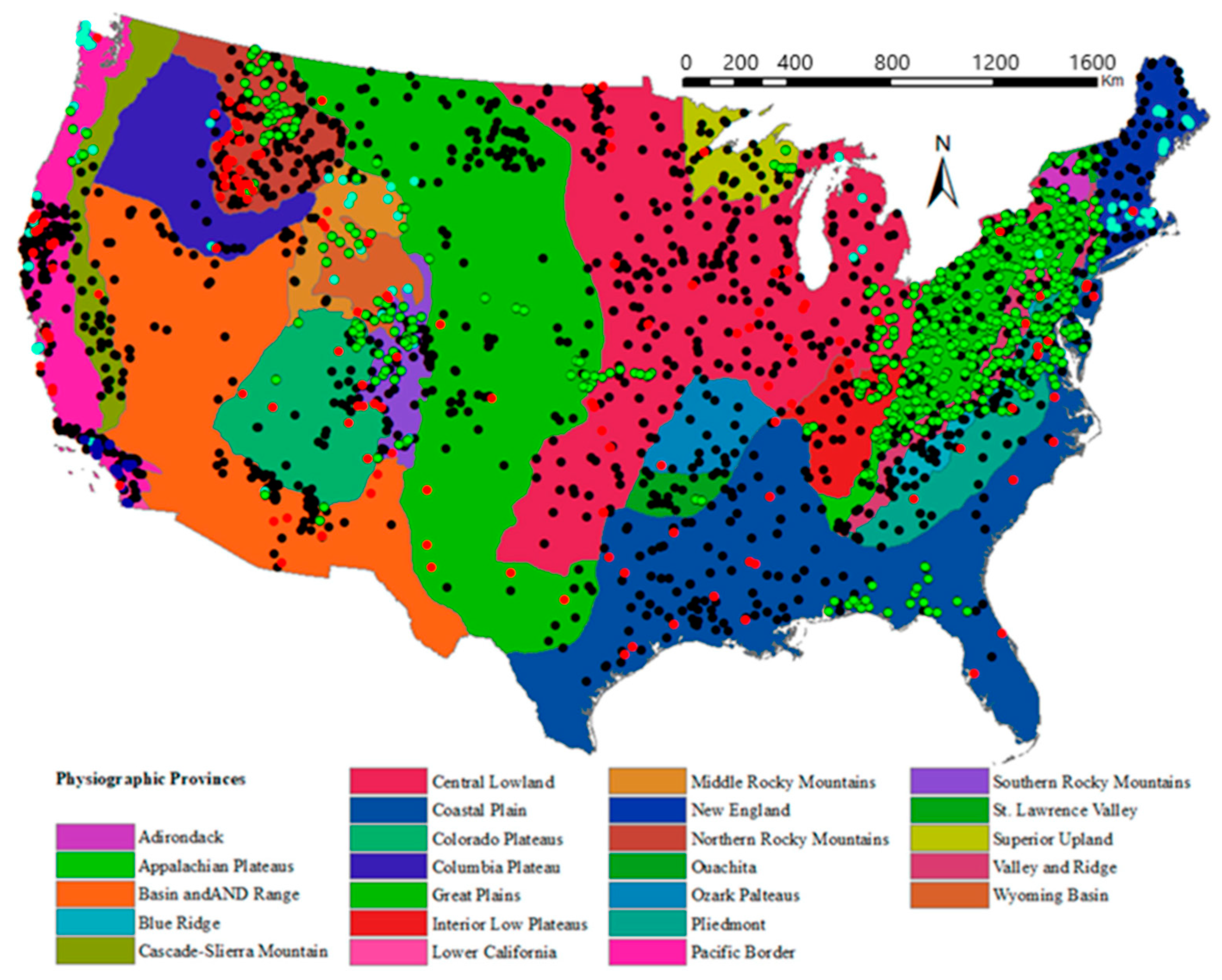
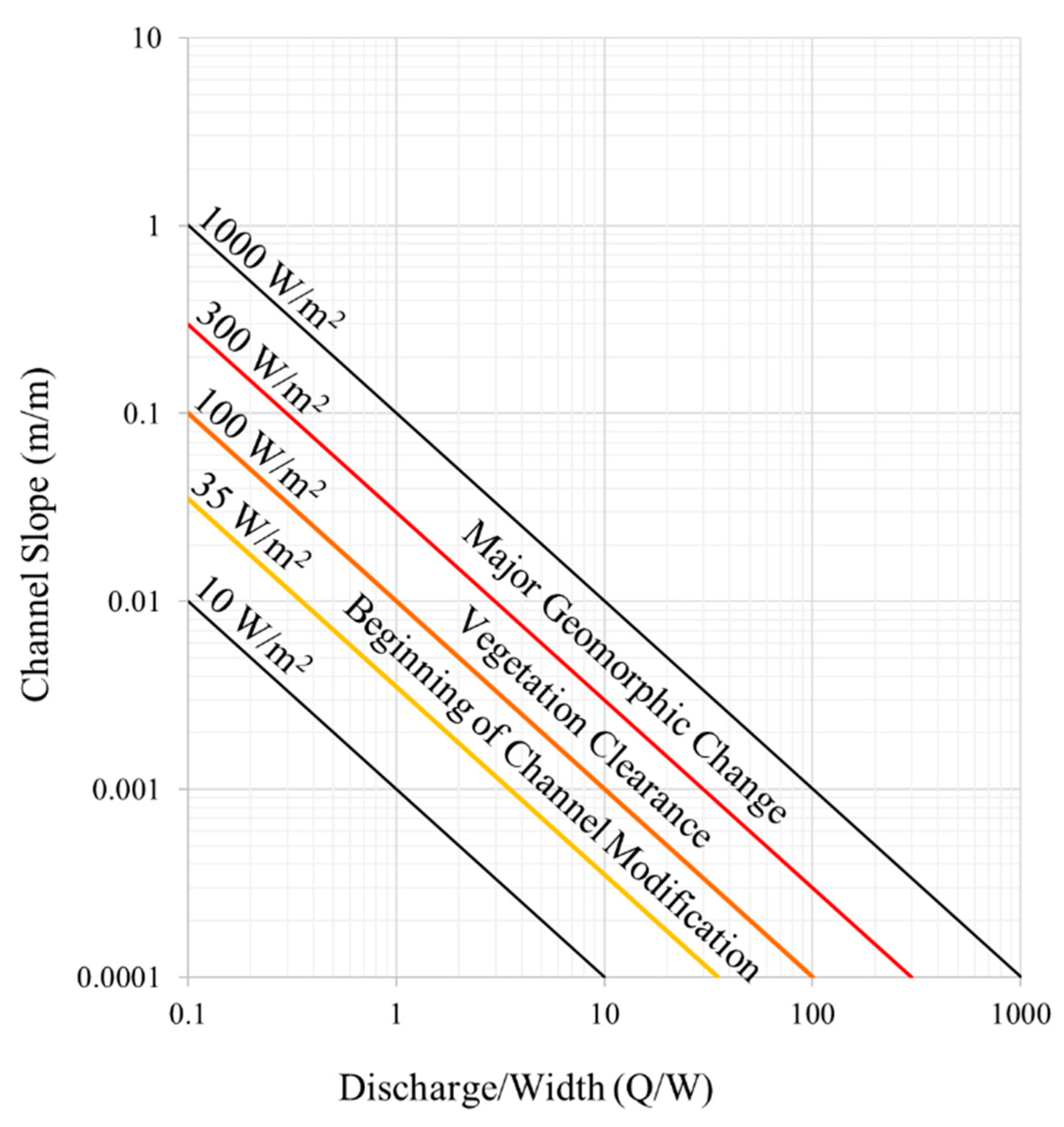
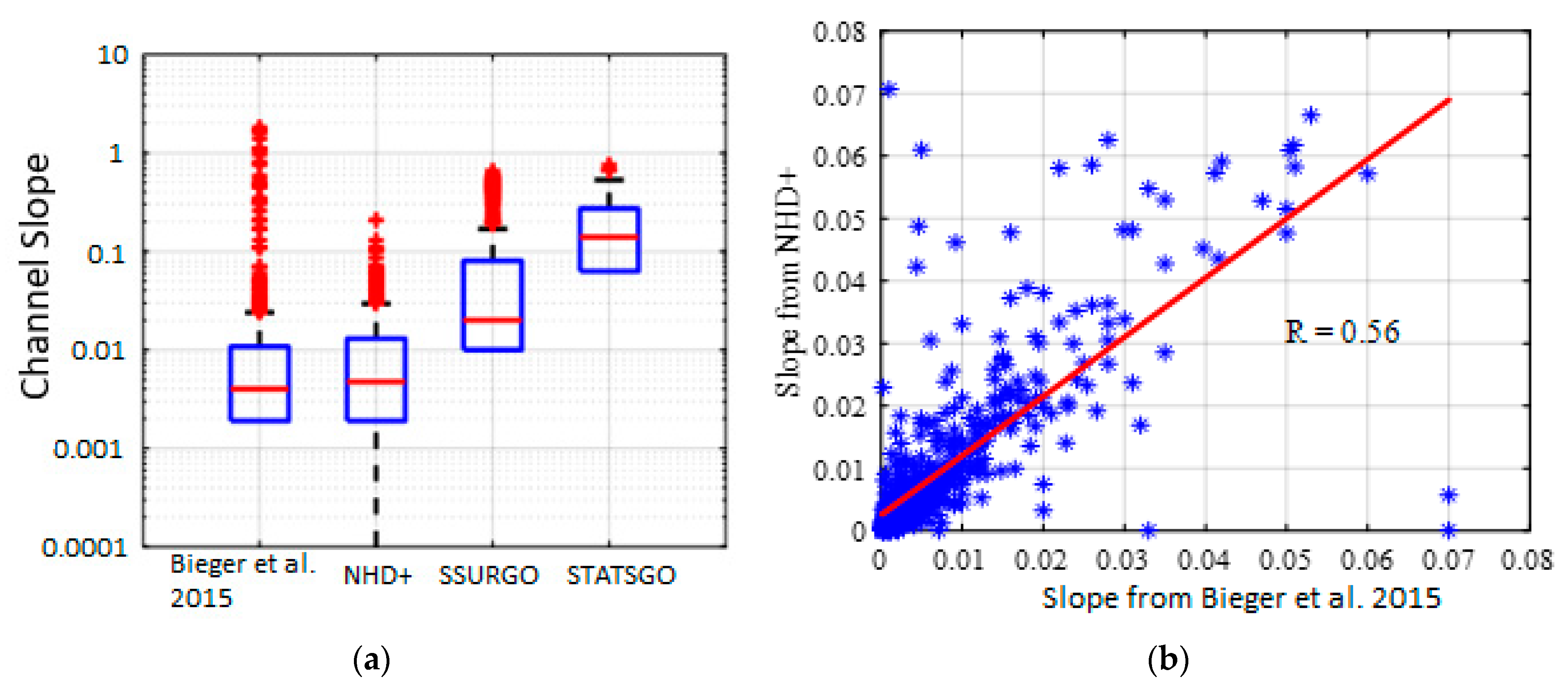
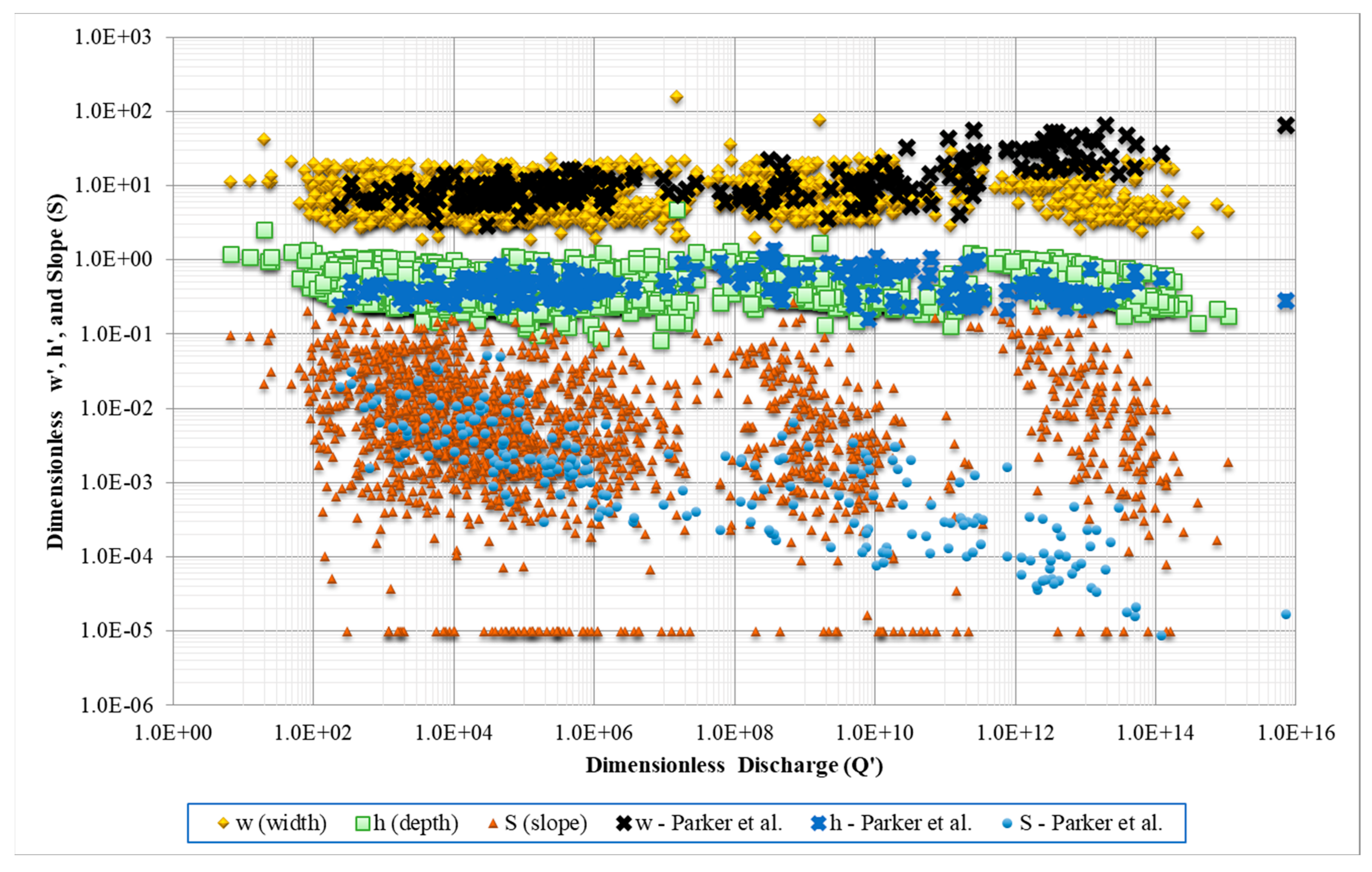
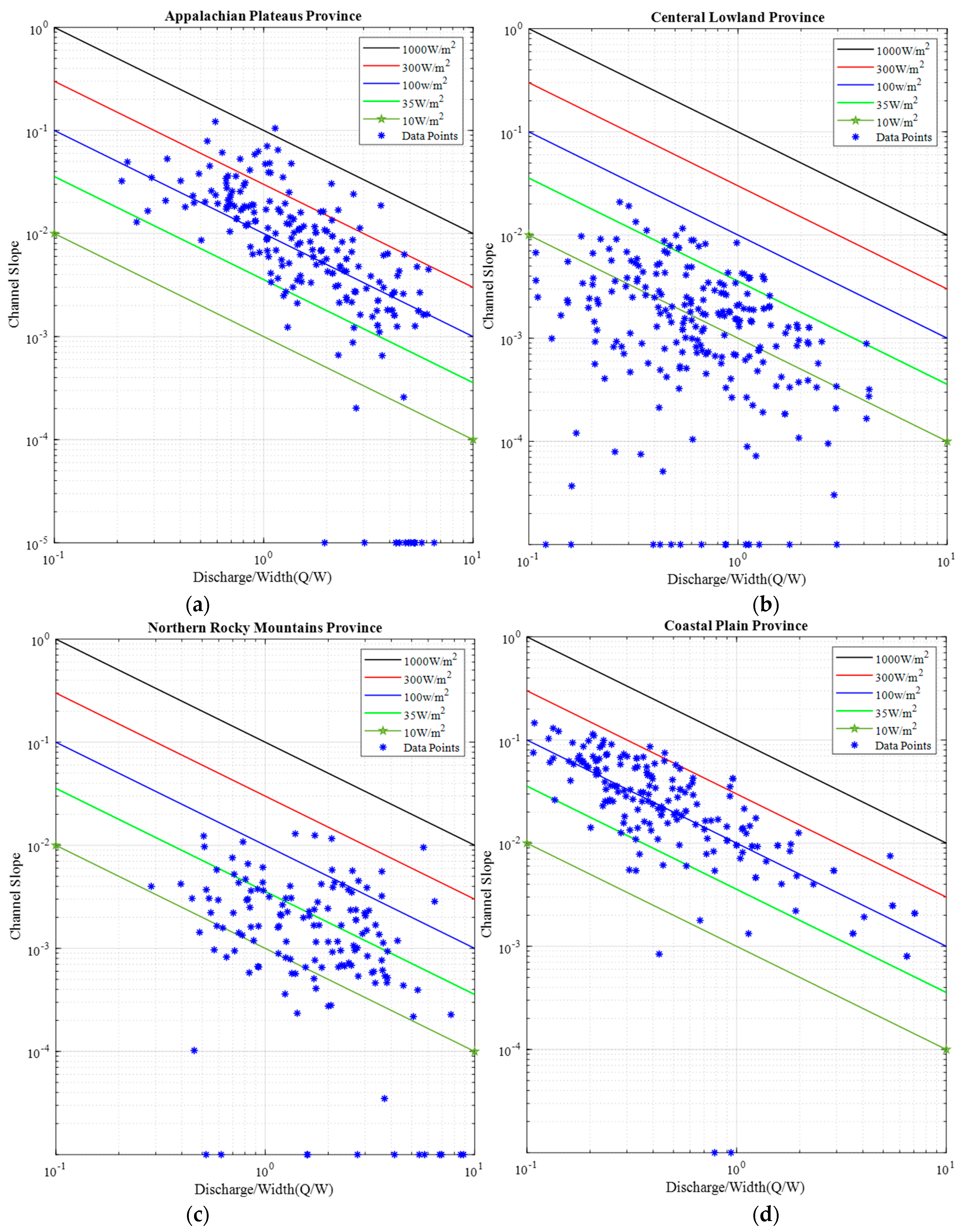
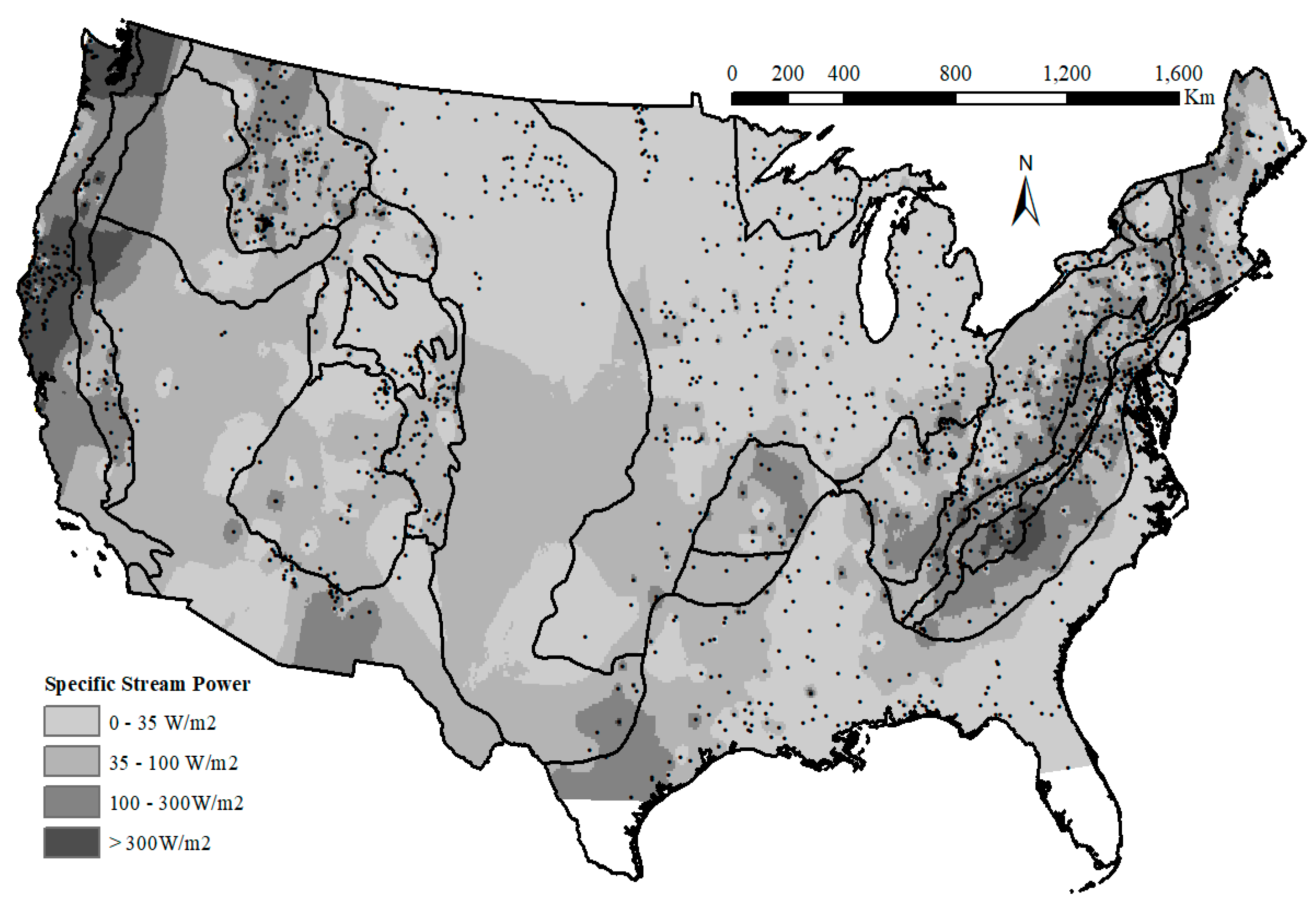

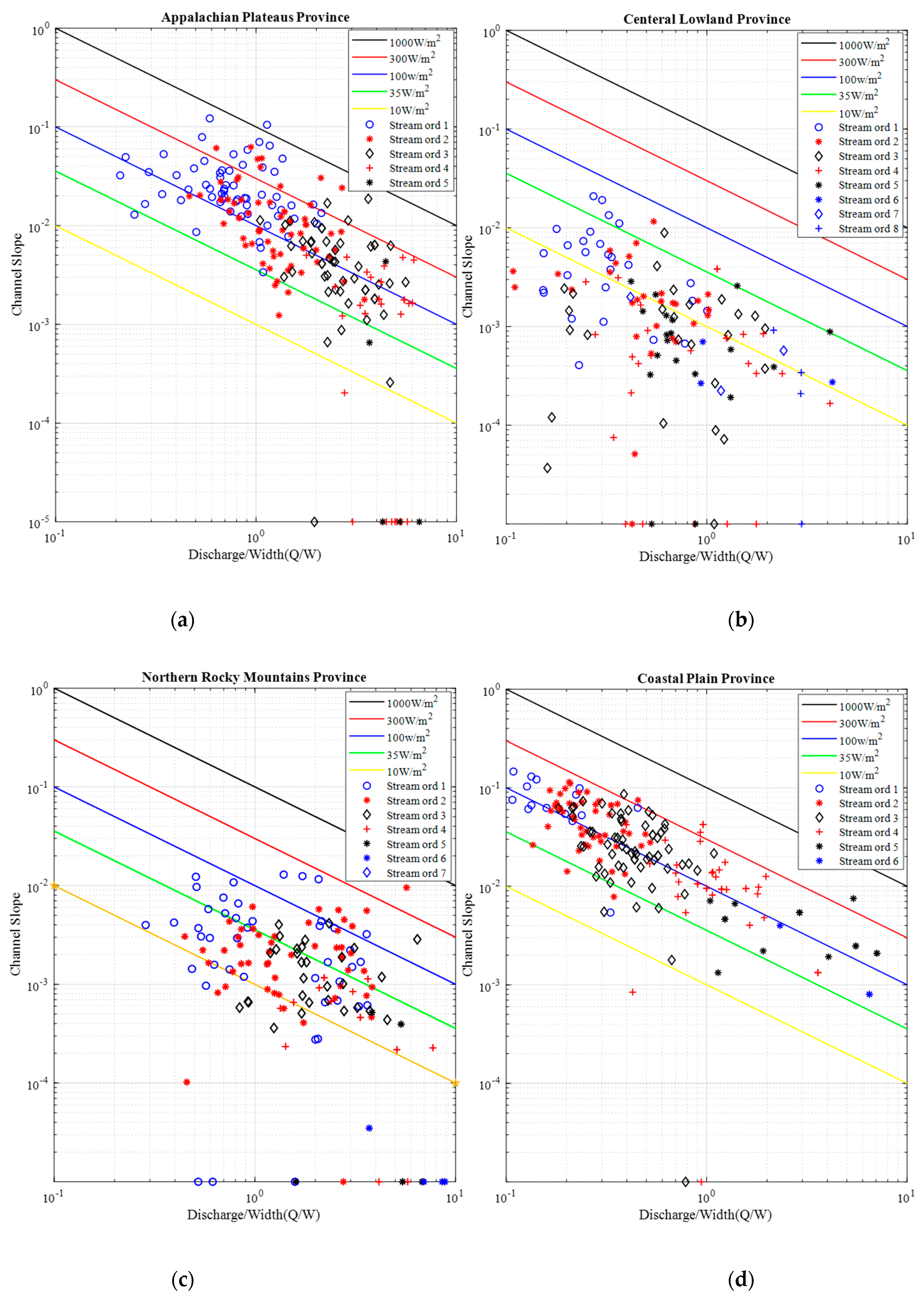
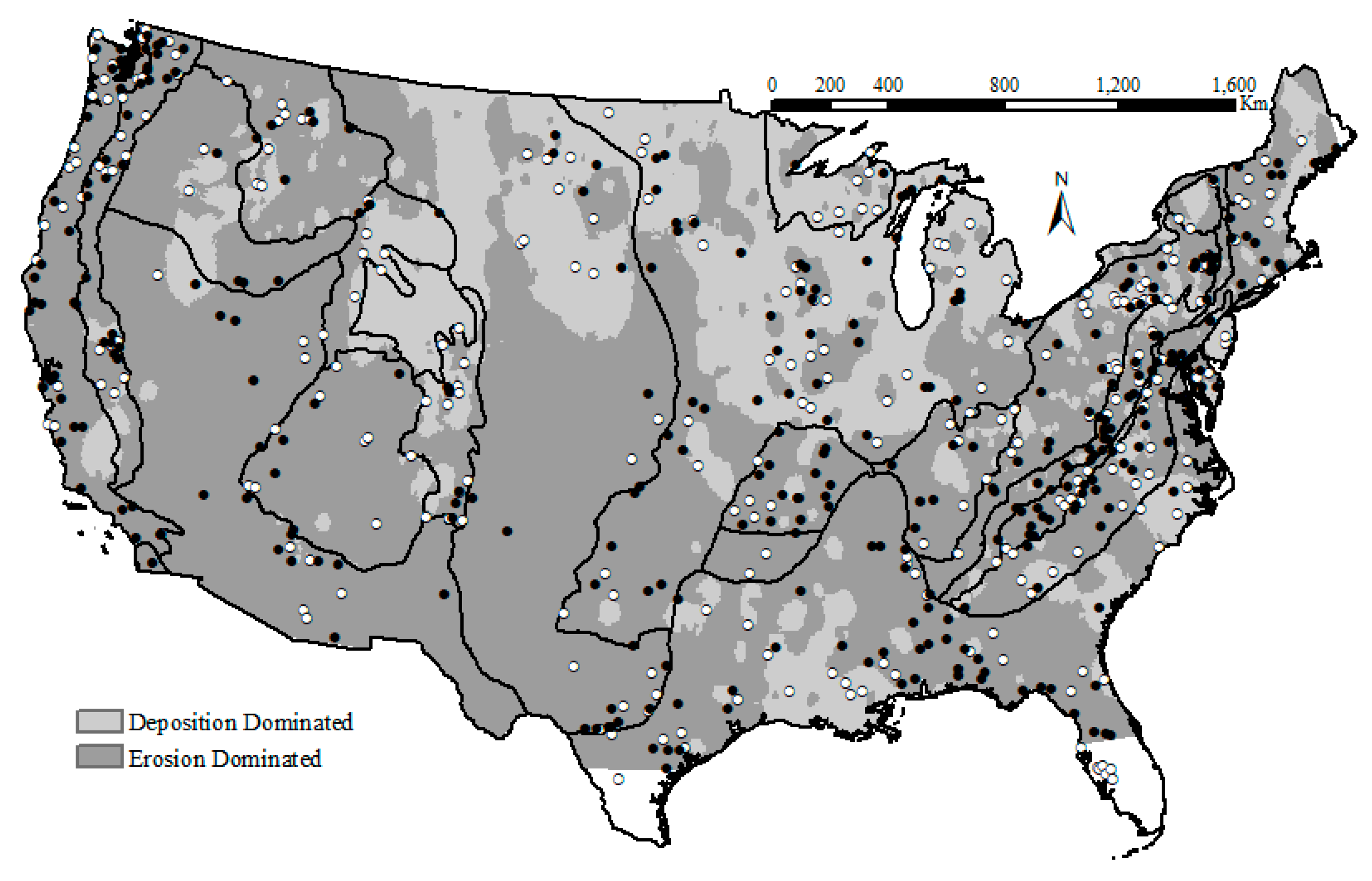
| Data Source | Hydrological Parameter | Number of Data Points |
|---|---|---|
| Bieger et al. [33] | Q, D50, W, D, S and DA | 642 |
| Bledsoe et al. [1] | Q, D50 and DA | 103 |
| USEPA [34] | D50 | 1387 |
| Hawley and Bledsoe [35] | D50 | 66 |
| Slater and Singer [36] | D50, W, D, S and DA | 255 |
| Range | Percentage of Data with Stream Power | |||||||
|---|---|---|---|---|---|---|---|---|
| Physiographic Provinces | Slope | Width (m) | Discharge (Q) (m3/s) | Stream Power (W/m2) | No. of Data | <15 W/m2 | >35 W/m2 | >300 W/m2 |
| Adirondack | 0.00001–0.052 | 3.08–30.21 | 1.5–159 | 0.10–497 | 9 | 33.3% | 66.7% | 22.2% |
| Appalachian Plateaus | 0.00001–0.122 | 2.73–28.26 | 0.6–152 | 0.19–1169 | 217 | 7.4% | 88.9% | 10.6% |
| Basin And Range | 0.00001–0.158 | 1.70–109.3 | 0.17–152 | 0.02–422 | 50 | 14.0% | 76.0% | 2.0% |
| Blue Ridge | 0.00029–0.176 | 3.16–24.05 | 2.6–54 | 8.12–1853 | 22 | 4.5% | 90.9% | 50.0% |
| Cascade-Sierra Mountains | 0.00001–0.143 | 4.41–24.88 | 0.44–170 | 0.67–739 | 35 | 2.9% | 97.1% | 22.9% |
| Central Lowland | 0.00001–0.023 | 2.81–225.3 | 0.95–2371 | 0.02–911 | 241 | 38.6% | 36.5% | 0.4% |
| Coastal Plain | 0.00001–0.013 | 2.99–27.20 | 1.06–17819 | 0.05–533 | 161 | 33.5% | 36.0% | 0.6% |
| Colorado Plateaus | 0.00070–0.118 | 3.55–104.25 | 0.19–141 | 5.83–201 | 65 | 10.8% | 50.8% | 0.0% |
| Columbia Plateau | 0.00027–0.021 | 12.49–94.09 | 0.86–570 | 14.47–57 | 4 | 25.0% | 25.0% | 0.0% |
| Great Plains | 0.00001–0.050 | 6.04–107.95 | 0.97–176 | 0.01–328 | 74 | 81.1% | 14.9% | 1.4% |
| Interior Low Plateaus | 0.00001–0.061 | 3.12–57.93 | 2.03–589 | 0.44–799 | 65 | 6.2% | 83.1% | 3.1% |
| Middle Rocky Mountains | 0.00001–0.209 | 3.01–37.87 | 0.12–20 | 0.03–358 | 27 | 18.5% | 66.7% | 3.7% |
| New England | 0.00001–0.039 | 2.95–24.51 | 2.2–101 | 0.12–511 | 123 | 9.8% | 82.1% | 2.4% |
| Northern Rocky Mountains | 0.00001–0.207 | 2.74–79.37 | 0.07–1695 | 0.08–700 | 197 | 2.5% | 92.4% | 3.6% |
| Ouachita | 0.00160–0.003 | 10.58–12.91 | 42.1–55 | 65.81–114 | 4 | 0.0% | 100% | 0% |
| Ozark Plateaus | 0.00001–0.007 | 6.55–38.66 | 18–387 | 0.98–285 | 15 | 13.3% | 86.7% | 0.0% |
| Pacific Border | 0.00001–0.295 | 3.35–95.59 | 2.5–2084 | 0.44–2628 | 132 | 3.8% | 94.7% | 65.2% |
| Piedmont | 0.00001–0.084 | 2.63–24.99 | 2.79–128 | 0.28–700 | 109 | 3.7% | 92.7% | 5.5% |
| Southern Rocky Mountains | 0.00001–0.113 | 4.34–99.55 | 0.29–132 | 0.04–240 | 78 | 3.8% | 83.3% | 0.0% |
| St. Lawrence Valley | 0.00420–0.017 | 5.75–14.22 | 3.22–24 | 70.04–197 | 3 | 0.0% | 100.0% | 0.0% |
| Superior Upland | 0.00001–0.015 | 4.37–31.76 | 1.76–51 | 0.06–95 | 27 | 51.9% | 14.8% | 0.0% |
| Valley and Ridge | 0.00040–0.048 | 2.56–31.07 | 1.35–169 | 15.61–564 | 140 | 0.0% | 96.4% | 6.4% |
| Wyoming Basin | 0.00001–0.062 | 7.06–69.63 | 0.75–106 | 0.07–98 | 30 | 50.0% | 13.3% | 0.0% |
| Lower California | – | – | – | – | – | – | – | – |
| Range | Percentage of Data Points with Stream Power | ||||||
|---|---|---|---|---|---|---|---|
| Stream Order | Slope | Discharge (Q) (m3/s) | Stream Power (W/m2) | No. of Data | <15 W/m2 | >35 W/m2 | >300 W/m2 |
| 1 | 0.00001–0.295 | 0.073–192.5 | 0.02–2627.6 | 311 | 9.00% | 82.32% | 17.68% |
| 2 | 0.00001–0.209 | 0.302–222.8 | 0.03–2003.9 | 508 | 9.06% | 78.35% | 10.04% |
| 3 | 0.00001–0.143 | 0.566–503.4 | 0.01–1641.9 | 504 | 14.09% | 72.82% | 7.94% |
| 4 | 0.00001–0.062 | 1.316–839.1 | 0.02–2358.9 | 322 | 23.29% | 64.29% | 3.73% |
| 5 | 0.00001–0.023 | 5.371–620.7 | 0.03–398.4 | 121 | 48.76% | 39.67% | 2.48% |
| 6 | 0.00001–0.005 | 20.76–2084.2 | 0.06–700.4 | 42 | 52.38% | 21.43% | 2.38% |
| 7 | 0.00001–0.007 | 15.5–17818.7 | 0.14–98.96 | 16 | 56.25% | 25.00% | 0.00% |
| 8 | 0.00001–0.001 | 807.3–2370.7 | 1.03–45.2 | 4 | 25.00% | 50.00% | 0.00% |
Publisher’s Note: MDPI stays neutral with regard to jurisdictional claims in published maps and institutional affiliations. |
© 2022 by the authors. Licensee MDPI, Basel, Switzerland. This article is an open access article distributed under the terms and conditions of the Creative Commons Attribution (CC BY) license (https://creativecommons.org/licenses/by/4.0/).
Share and Cite
Jha, M.K.; Asamen, D.M.; Allen, P.M.; Arnold, J.G.; White, M.J. Assessing Streambed Stability Using D50-Based Stream Power Across Contiguous U.S. Water 2022, 14, 3646. https://doi.org/10.3390/w14223646
Jha MK, Asamen DM, Allen PM, Arnold JG, White MJ. Assessing Streambed Stability Using D50-Based Stream Power Across Contiguous U.S. Water. 2022; 14(22):3646. https://doi.org/10.3390/w14223646
Chicago/Turabian StyleJha, Manoj K., Dawit M. Asamen, Peter M. Allen, Jeffrey G. Arnold, and Michael J. White. 2022. "Assessing Streambed Stability Using D50-Based Stream Power Across Contiguous U.S." Water 14, no. 22: 3646. https://doi.org/10.3390/w14223646






